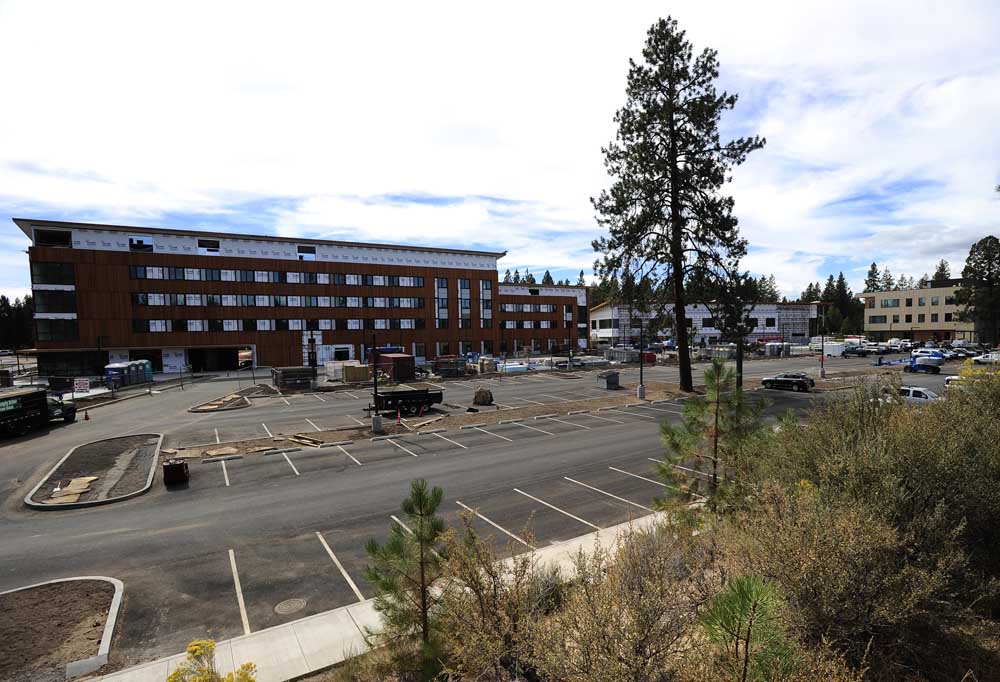OSU-Cascades was decades in the making
Published 12:00 am Sunday, September 11, 2016

- Ryan Brennecke / The BulletinConstruction continues at the OSU-Cascades campus in Bend in early September 2016.
Crews broke ground on Oregon State University’s Cascades campus only last year, but the expansion of higher education in Central Oregon has been more than 30 years in the making and involved the effort of many local leaders, university officials and lawmakers.
As early as 1979, Central Oregon Community College and Oregon State University considered ways to expand access to higher education in the region. COCC’s president at the time, Fred Boyle, sought to allow the community college to offer upper-division and graduate-level courses.
At one point the two schools agreed to co-sponsor a liberal studies bachelor’s degree, but the state’s university system did not approve.
By the 1990s, COCC had worked out agreements with OSU and other public and private schools in the state to offer programs on the college’s Bend campus. These included courses in business from Linfield College, classes in nursing from Oregon Health Sciences University, instruction in social work from Portland State University, and so on.
The arrangement, which became known as the University Center, allowed local students to complete undergraduate and graduate degrees here. But the offerings weren’t consistent. Some took place on weekends, some were merely video feeds from a remote main campus and others simply disappeared from one year to the next.
“I came to the conclusion that the University Center was never going to work for us. It was always the poor stepchild,” said Neil Bryant, who back then was Bend’s state senator and now leads the state’s Higher Education Coordinating Commission. Schools in the Willamette Valley would always take priority, he said.
So in 1997 Bryant introduced a bill that would allow COCC to grant four-year degrees. That didn’t sit well with the state Board of Higher Education, and Bryant agreed to drop the proposal if the chancellor of higher education agreed to create a group to look at higher-education options in Central Oregon.
“It was not an easily won acknowledgment, because the politics of education in the ’90s,” said Bob Barber, who was president of COCC from 1990 to 2004. The effort occurred after the passage of Measure 5, he noted, which capped property taxes for school funding.
“Institutions, whether they be community colleges or universities, they were very reluctant to let new programs start because it would mean draining resources,” Barber said. “Let’s just say it was a contentious discussion.”
The Central Oregon Regional Advisory Board was created in 1999. It set out to improve local access to higher education, whether through the establishment of a new public or private school or the creation of a branch campus of an existing institution.
“We didn’t want to be another study group that said, ‘Oh, wouldn’t it be nice if we had a four-year institution here,’” said Patricia Moss, a member of the advisory board. “I think several members of CORAB were surprised really (that) the branch campus was a reasonable solution.”
Under the plan that emerged, students could take lower-division classes at COCC, then take upper-division classes at the branch campus to complete a bachelor’s degree. Rather than starting a school from scratch — and undergoing a lengthy accreditation process — the branch campus would benefit from the existing school’s reputation.
OSU and the University of Oregon put in proposals to open a branch in Bend. UO’s plans involved sending sabbatical professors to Central Oregon for six months to a year, while OSU said it would base faculty here, according to Barbara Schenck, the chairwoman of CORAB.
“The OSU proposal was so strongly committed to placing faculty in our community, who would shop in our stores and vote in our elections and be here for our students,” Schenck said.
The state Board of Higher Education picked OSU to open a branch offering a two-year “capstone” program of instruction. But the goal, Schenck said, was always to expand that into a four-year campus — a goal shared by then-OSU President Paul Risser.
“He said, ‘It will fly free.’ That was the term he used, ‘It will fly free,’” Schenck said.
In 2001 then-Gov. John Kitzhaber included money for the branch in his budget, and the Legislature approve $7.2 million in start-up funds that July.
OSU-Cascades opened in 2001 on COCC’s campus. Henry Sayre, an art history professor and president of the faculty senate in Corvallis, was picked to be the branch campus’ top administrator.
“We were determined to make it go. What was rough was we opened the door, literally, on Sept. 11, 2001,” he said.
Sayre had planned on a budget in excess of $10 million for the branch.
“Within a couple weeks we were told we had $6.3 million. That made it a rough go from the beginning,” he said.
Meanwhile, the University of Oregon was still offering classes in Bend, creating competition for students. And back in Corvallis, Sayre said, many believed money going to the Cascades branch was coming out of the main campus’ budget.
Despite the challenges, enrollment at OSU-Cascades grew steadily, from 360 in 2001 to 640 in 2006 to 935 in 2011, by then housed at Cascades Hall on COCC’s campus, which OSU leased from the community college.
That year, OSU President Ed Ray announced in his annual State of the University speech that the branch intended to buy a building to house its graduate programs. The Graduate & Research Center opened on SW Columbia Street that fall, planting the seed for a four-year campus to be developed nearby.
In spring 2012, Ray returned to Bend to announce the goal of serving up to 5,000 students on a four-year campus by 2025, and the Oregon University System approved the expansion plan that August.
— Reporter: 541-617-7837,
aspegman@bendbulletin.com






